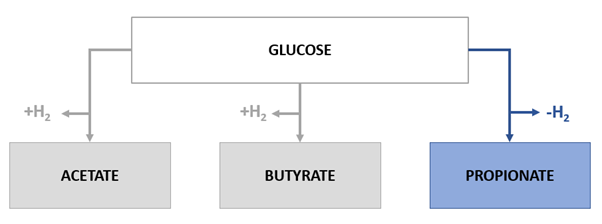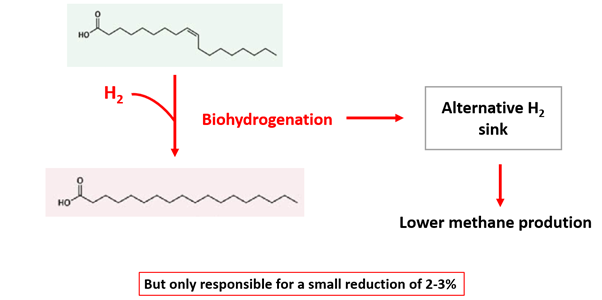INTRODUCTION
During enteric fermentation, feed is broken down to fatty accids (which are building blocks for further development in the body), CO2 and hydrogen (H), among other things. H is removed by methanogenic microorganisms, and converted along with CO2 to enteric methane. This is a natural process and is necessary because high levels of H will disturb the digestive system.
Enteric CH4 is being released by burping. For an adult cow, the average emissions range from 200-500 g CH4/day. Beef cattle will emit lower levels compared to dairy cattle. However, if we look at the total emissions for beef cattle, it ranges from 14-32 kg CO2-eq/kg edible beef. This is a wide range, because many beef production systems exist. A more intensive system will have lower emission levels, compared to extensive production systems. This is due to the use of concentrates in intensive systems, and more grazing in extensive systems. For this, feed management is a practice often used to influence enteric CH4 emissions and shows rather quick results. Within the different feed strategies, the use of fats is a well-known and broadly used feed ingredient. In this part, we will explain more on the working mechanism of fats.
WORKING MECHANISM OF FATS
1. Lower levels of fermentable organic matter
The addition of fat leads to a lower amount of fermentable organic matter. Fats are not fermented in the rumen and will not lead to the production of methane. When we add fat to the diet, this fat also replaces another feed in the diet. Usually this replaced feed contains fermentable carbohydrates, which leads to the production of intestinal methane. In addition, fats also have a coating effect on the fibre particles in the ration, making them less available for fermentation in the rumen.
2. Production of propionic acid
The addition of dietary fats leads to higher production of propionic acid. Propionic acid is a volatile fatty acid that consumes hydrogen gas. As a result, less H is available for the formation of methane.
This is due to the lower amount of structural carbohydrates (because they are partially replaced by fats), because there is less available for fermentation in the rumen due to the coating effect of the fats. Less structural carbohydrates will also lead to a shift of microorganisms to more propionic acid-producing microorganisms. All this will lead to a shift in production of volatile fatty acids to more propionic acid.
The production of propionic acid will act as an alternative pathway for consuming hydrogen ions, meaning that hydrogen will be used for propionic acid production and will not be available for methane production. In turn, the other volatile fatty acids, acetic acid and butyric acid, cause more hydrogen gas to be produced, leading to an increase in CH4.
 |
3. Inhibition of microorganisms in the rumen
Dietary fats will inhibit rumen microorganisms. Protozoa are affected by the addition of dietary fat. Since protozoa are important producers of hydrogen, inhibition of them affects the amount of hydrogen released into the rumen. In addition, methanogenic bacteria have a close relationship with the protozoa, leading to an efficient methane production system. Thus, inhibition of the protozoa leads to lower methane production.
4. Biohydrogenation of unsaturated fatty acids
Biohydrogenation is a process in the rumen where unsaturated fats are converted to saturated fats. The main difference between these two types of fatty acids is the occurrence of a double bond in their carbon chain. This process is necessary because unsaturated fats have a negative impact on rumen microorganisms. This process requires H, so there is less H available for methane production. However, biohydrogenation is only responsible for a small reduction in methane emissions. Only 2-3% of rumen methane reduction can be attributed to this process.
 |
INFLUENCING FACTORS OF FATS
The amount of fat also plays an important role. The more fat added to the feed, the lower the CH4 production will be. However, this is up to a certain amount, because if we increase the proportion of fat in the ration too much, the feed intake will decrease.
As mentioned earlier, the source of fat is also important. Unsaturated fat will have a greater reducing potential than saturated fat.
The form of the fat is also important. If oil is added, less methane will be emitted, compared to the whole raw material.
Finally, the composition of the feed also has an influence. The methane-reducing effect of fats is greater when they are added in a concentrate feed, compared to addition in roughage.
IMPACT ON FARM PERFORMANCES
Socio-economic resilience
- Depending of the way of adding fat, it is possible to not influence the price of the meat (cost-benefit analysis)
Animal health and welfare
- Going too high in fat may impair cattle health
Production efficiency and meat quality
- xx
Environmental sustainability
- Lower enteric methane emissions
DEMONSTRATION
A farm in Belgium is implementing linseed in the ration of their beef cattle. In the next video, we explain more about the effect of feed on the environment and the farmers talks about her experience with this diet.
https://www.youtube.com/watch?v=mr3KOxDaSyI (Spoken in Dutch, with English subtitles)